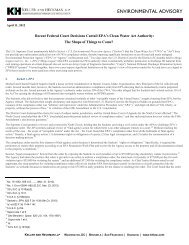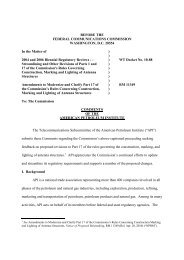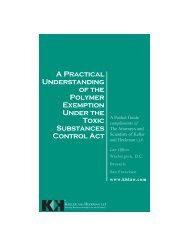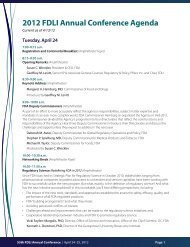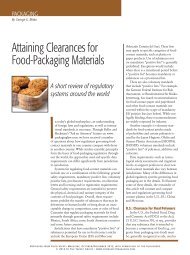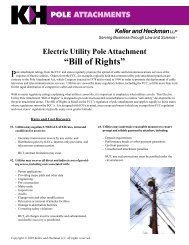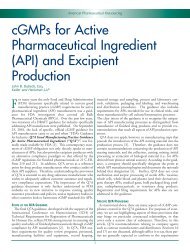Ron Chance
Ron Chance
Ron Chance
You also want an ePaper? Increase the reach of your titles
YUMPU automatically turns print PDFs into web optimized ePapers that Google loves.
A Cyanobacteria-Based Photosynthetic Process for<br />
the Production of Ethanol<br />
<strong>Ron</strong> <strong>Chance</strong>, Ben McCool, and John Coleman<br />
Presentation ti to National Research Council<br />
June 13, 2011
Background — Algae Cultivation<br />
• Microalgae/Cyanobacteria<br />
• Photoautotrophs—carry out photosynthesis (sunlight, CO 2 ,<br />
and water to organic molecules)<br />
• Much higher h productivity it than larger plants (~30x)<br />
• 10’s of thousands of known species including blue green<br />
algae (cyanobacteria)<br />
• Commercial production of high value products<br />
• Aquatic Species Program (NREL 1980-95)<br />
• Focus on bio-diesel production from harvested algae<br />
• Favored Open Pond vs. Closed Systems<br />
• Pilot plant in New Mexico<br />
• Major issues with economics and contamination<br />
Open Ponds (Raceway Design)<br />
Microalgae to High Value Products<br />
Cyanotech, Big Island, Hawaii<br />
• Current Status – Biofuel Production<br />
• Numerous algae-to-fuels companies<br />
• Almost all based on production from harvested algae<br />
• Mixture of open pond and closed systems<br />
• None with demonstrated commercial viability for biofuels<br />
Raceway Pond Design from<br />
Aquatic Species Program<br />
2<br />
2
Algenol Overview<br />
• Algenol is an advanced industrial biotechnology<br />
company founded in 2006<br />
• Headquartered in Bonita Springs, Florida<br />
• Research labs in Fort Myers, Florida and Berlin,<br />
Germany<br />
• 120 employees and consultants including 60<br />
PhDs<br />
• Algenol is developing its patented cyanobacteriabased<br />
technology platform for ethanol production<br />
• Unique no harvest, Direct to Ethanol © technology<br />
with low biomass waste<br />
• $25MM DOE grant for Integrated Biorefinery<br />
o Project passed DOE Gate 1<br />
o Partnered with Dow Chemical, NREL,<br />
Georgia Tech, Membrane Tech &<br />
Research, University of Colorado<br />
• Other key partners: Linde, Valero, Biofields,<br />
Honeywell<br />
2 CO 2 + 3 H 2 O<br />
C 2 H 5 OH + 3 O 2<br />
Direct To Ethanol ® technology<br />
1000 L scale indoor experiments (Florida)<br />
3
Algenol Research and Development Facilities<br />
• New Fort Myers, Florida facility which consolidates Algenol’s<br />
existing U.S. lab and outdoor testing facilities<br />
• 40,000 ft 2 lab space (biology, physiology, engineering)<br />
• 4 acre outdoor Process Development elopment Unit (aquaculture) ac • 36 acres for pilot testing (17 acre DOE-funded pilot)<br />
• Berlin labs (Cyano Biofuels, wholly-owned Algenol subsidiary)<br />
• Screening of wild-type organisms<br />
• Metabolic Engineering<br />
• Lab to medium scale characterization of ethanol<br />
production<br />
Fort Myers Laboratory (Completed August 2010)<br />
Berlin Laboratory Group<br />
Process Development Unit<br />
Commercial Scale Photobioreactors<br />
4
DIRECT TO ETHANOL ® Commercial Vision<br />
Enhanced cyanobacteria, CO 2 and solar energy to produce ethanol<br />
2CO 2 +3H 2 O C 2 H 5 OH + 3 O 2<br />
CO 2 can be sourced from:<br />
• Power Plant<br />
• Refinery or Chem. Plant<br />
• Cement Plant<br />
• Natural Gas Well<br />
• Ambient Air<br />
Return Water<br />
Closed photobioreactors (seawater)<br />
Very low freshwater consumption<br />
No-harvest strategy<br />
Ethanol collected from vapor phase<br />
5
Biological Carbon Platform<br />
Cyanobacteria (blue-green algae)<br />
• Fast-growing photosynthetic prokaryotes<br />
with high rates of photo-conversion of<br />
CO 2 into photosynthate and biomass<br />
• Capacity for stable genetic<br />
enhancement with available molecular<br />
tools<br />
• High rates of CO 2 /HCO 3 assimilation in<br />
marine and freshwater environments<br />
• Defined inorganic i growth medium with<br />
no organic C sources required<br />
• Amenable for growth in enclosed<br />
• photobioreactors<br />
Wide range of growth forms and ecotypes among different genera<br />
Dr. Heike Enke,<br />
CSO, Berlin<br />
• Over 1500 curated strains from diverse environments available in-house within the<br />
Algenol Biofuels Culture Collection (ABCC)<br />
• Screening program used to identify candidate species for genetic enhancement<br />
• Candidate species selected on the basis of numerous physiological, morphological and<br />
molecular criteria<br />
6
Metabolic Pathway for Ethanol Production<br />
Enhanced cyanobacteria, photobioreactors, and ethanol separation systems are key,<br />
proprietary components of the Algenol technology.<br />
2 CO 2 + 3 H 2 O C 2 H 5 OH + 3 O 2<br />
Enhanced ethanol production via over-expression of genes for fermentation pathway<br />
enzymes<br />
• These enzymes, pyruvate decarboxylase (PDC) and alcohol dehydrogenase<br />
(ADH), are found widely in nature.<br />
• PDC catalyzes the non-oxidative decarboxylation of pyruvate to produce<br />
acetaldehyde.<br />
• ADH converts acetaldehyde to ethanol.<br />
• Ethanol diffuses from the cell into the culture medium and is collected without<br />
the need to destroy the organism.<br />
7
Photosynthetic Efficiency and Productivity Targets<br />
Ethanol Production Target<br />
• Algenol target is 6000 gal/acre-yr<br />
• Corn is about 400 gal/acre-yr; sugarcane about 1000<br />
• Target corresponds to roughly 2% solar energy conversion<br />
efficiency (referenced to average US solar radiation)<br />
• Efficiency similar to commercial biomass conversion for<br />
Chlorella (food supplements) as well as conventional crops<br />
• Equivalent to about 20 g/m 2 biomass production, with about<br />
70 having been reported in the literature<br />
• Absolute theoretical limit (8 photons per C fixed, or 24 for<br />
ethanol) is about 40,000 gal/acre-yr of ethanol or about 130<br />
g/m 2 of biomass<br />
Fort Myers Physiology Lab<br />
Potential Yield Limitations<br />
• Light (photosaturation, photoinhibition)<br />
• Diversion of fixed carbon to non-ethanologenic pathways<br />
• Contaminants<br />
t<br />
• Availability of CO 2<br />
• Nutrient supply<br />
Photosaturation Illustration<br />
(Melis, Plant Science, 2009)<br />
8
Photobioreactor Technology<br />
Enhanced cyanobacteria, photobioreactors, and ethanol separation systems are key,<br />
proprietary components of the Algenol technology.<br />
• Algenol grows ethanologenic algae<br />
in patented photobioreactors<br />
(PBRs) which allow for optimum<br />
solar transmission and efficient<br />
ethanol collection<br />
• Made of polyethylene with<br />
special additives and coatings<br />
to optimize performance<br />
• 4500 liter seawater culture<br />
• 15m long X 1.5m wide<br />
• Ethanol-freshwater condensate is<br />
collected from photobioreactors and<br />
concentrated to feedstock-grade or<br />
fuel-grade ethanol using a<br />
combination of Algenol proprietary p and conventional technology.<br />
EtOH Separation<br />
EtOH Separation<br />
First step in purification process is accomplished with solar energy<br />
and provides a clean, ethanol-freshwater solution.<br />
9
Low Energy Mixing Technology<br />
• Keep organisms suspended<br />
d<br />
• Facilitate gas exchange<br />
• Ensure nutrient availability<br />
Experimental Techniques for<br />
Flow Visualization - Laser Sheet<br />
Visualization<br />
Computational Methods for Mixing<br />
System Modeling and Next<br />
Generation Design – CFD<br />
10
Ethanol Purification Technology<br />
Photo-Bioreactor<br />
0.5 – 2 wt%<br />
Vapor Compression<br />
Steam Stripping<br />
EtOH Separation<br />
0.14<br />
partial pr ressure of EtOH<br />
(atm)<br />
0.12<br />
010 0.10<br />
0.08<br />
0.06<br />
0.04<br />
0.02<br />
Ethanol-Water Phase Diagram<br />
EtOH Separation<br />
Ethanol vapor pressure<br />
at 35°C<br />
Raoult's law (γ e = γ w =1)<br />
5 – 20 wt%<br />
Conventional Dist.<br />
Vapor Compression Dist.<br />
Membrane Separation<br />
Mol Sieve<br />
Extract. Dist.<br />
Membrane<br />
90 - 95 wt%<br />
0.00<br />
0 0.2 0.4 0.6 0.8 1<br />
mole fraction of EtOH in water<br />
99.7% Fuel Grade<br />
11
Energy Demand for Direct to Ethanol ® Process<br />
• VCSS is a largest energy consumer • Energy demand d for mixing, i gas<br />
• Energy demand depends strongly on delivery, pumping, etc. added in*<br />
ethanol concentration in condensate* • Total system energy demand plotted<br />
• At 1% condensate, VCSS represents<br />
vs. condensate concentration for<br />
about 20% parasitic load<br />
different dehydration options**<br />
0.60<br />
Energy Consumption Determined by Process Simulations (GaTech* , **)<br />
(Input to Life Cycle Analysis)<br />
0.60<br />
onsumption (MJ/M MJ)<br />
VCSS Energy C<br />
0.50<br />
0.40<br />
0.30<br />
0.20<br />
0.10<br />
000 0.00<br />
0.0 1.0 2.0 3.0 4.0 5.0 6.0<br />
wt% Ethanol in Condensate<br />
T otal Process Energ gy Consumption (M MJ/MJ)<br />
0.50<br />
0.40<br />
0.30<br />
0.20<br />
0.10<br />
000 0.00<br />
VCSS+Distillation+Mol Sieve<br />
VCSS+Vapor Compression Distillation + Mol Sieve<br />
VCSS + Membrane<br />
0.0 1.0 2.0 3.0 4.0 5.0 6.0<br />
wt% Ethanol in Condensate<br />
*D. Luo, Z. Hu, D. Choi, V. Thomas, M. Realff, and R. <strong>Chance</strong>, Env. Sci. & Tech., 2010, 44 pp 8670–8677<br />
**D. Luo, Z. Hu, D. Choi, V. Thomas, M. Realff, B. McCool and R. <strong>Chance</strong>, unpublished results<br />
12
System Description for Life Cycle Analysis<br />
13
LCA for Evaluating Carbon Footprint and<br />
Technology Options<br />
Renewable Fuel Standard<br />
• LCA study is designed to be evergreen<br />
– continuously updated as part of our<br />
DOE project.<br />
• Renewable Fuel Standard is met in all<br />
scenarios studied.<br />
• LCA is important part of the evaluation<br />
of new technology options.<br />
• Example: Polymer membrane technology<br />
(MTR), in combination with Algenol’s<br />
process simulations and integration<br />
concepts, yields lower carbon footprint, as<br />
well as lower CAPEX and OPEX.<br />
• Work on waste biomass disposition, to be<br />
performed at NREL, will be incorporated into<br />
LCA and dtechno-economic model.<br />
Life Cycle Analysis Appears in: D. Luo, Z. Hu, D. Choi, V. Thomas, M.<br />
Realff, and R. <strong>Chance</strong>, Env. Sci. & Tech., 2010, 44 pp 8670–8677.<br />
14
Energy Cost and Carbon Footprint Comparison<br />
Transportation<br />
Fuel<br />
Fuel<br />
energy<br />
(MJ/gal)<br />
Production<br />
cost<br />
($/gal)<br />
Fuel to<br />
vehicle<br />
efficiency<br />
(MJ/MJ)<br />
Energy to vehicle<br />
(MJ/gal) Cents/MJ (vehicle)<br />
GHGs Emissions<br />
(g-CO2/MJ (vehicle))<br />
Gasoline 122.5 2.42 a 26% d 31.9 7.6 351 h<br />
Diesel 134.8 2.58 a 35% d 47.2 5.5 266 h<br />
Corn Ethanol 80.5 2.61 b 26% d 20.9 12.5 275 h<br />
Algenol Ethanol 80.5 1.37 c 26% d 20.9 6.6 55 i<br />
Grid to<br />
vehicle<br />
efficiency<br />
(MJ/MJ)<br />
Energy to vehicle<br />
(MJ/grid-MJ)<br />
GHGs Emissions<br />
(g-CO2/MJ (vehicle))<br />
$/grid-MJ<br />
Cents/MJ (vehicle)<br />
Grid Electricity<br />
(Residential<br />
Sector) US Average 0.032032 e 65% f,g 065 0.65 49 4.9 308 h<br />
a U.S. Energy Information Administration, “Gasoline and Diesel Fuel Update”. http://www.eia.gov/oog/info/gdu/gasdiesel.asp (accessed Feb 2011)<br />
b U.S. Energy Information Administration, “Annual Energy Outlook 2007 with Projections to 203”0. http://www.eia.gov/oiaf/archive/aeo07/issues.html (accessed Feb<br />
2011, Ethanol production prices adjusted for Corn and Natural Gas Market Prices as of Feb 2011)<br />
c Algenol’s Economic Model – Average production cost estimate with 6000 gal/acre-yr target (includes capital cost discounted over 15 years, and operating cost)<br />
d Crabtree, G., Argonne National Laboratory, “Where is Transportation Going?” http://ceet.mccormick.northwestern.edu/events/domain_dinner07/crabtree_domain_12-3-<br />
07.pdf (accessed Feb 2011)<br />
e U.S. Energy Information Administration, “Monthly Electric Sales and Revenue Report with State Distributions Report, Form EIA-826”.<br />
http://www.eia.gov/cneaf/electricity/page/eia826.html (accessed Feb 2011)<br />
f Elgowainy et. al., Argonne National Laboratory, “Well-to-Wheels Analysis of Energy Use and GHG Emissions of Plug-In-Hybrid Electric Vehicles”.<br />
www.transportation.anl.gov/pdfs/TA/559.pdf anl pdf (accessed Feb 2011)<br />
g U.S. Department of Energy,” Fuel Economy”. www.fueleconomy.gov (accessed Feb 2011)<br />
h Argonne National Laboratory, ”Greenhouse Gases, Regulated Emissions, and Energy Use in Transportation (GREET) Model”. http://greet.es.anl.gov/ (accessed Feb<br />
2011) [U.S. Mix Fuel assumed: Residual Oil (1.04%), Natural Gas (19.11%), Coal (47.24%), Nuclear Power (20.92%), Biomass (0.44%), Others (11.25%)]<br />
i D. Luo, Z. Hu, D. Choi, V. Thomas, M. Realff, and R. <strong>Chance</strong>, “Life Cycle Energy and Greenhouse Gas Emissions for an Ethanol Production Process Based on Blue-<br />
Green Algae” , Env. Sci. & Tech., 2010, 44 pp 8670–86778677<br />
15
Technical Partnerships/Leveraging<br />
Key Technical Areas<br />
PBRs; water treatment; process<br />
engineering; mixing systems<br />
Gas management; product separation;<br />
process engineering; CO 2 management;<br />
vapor liquid equilibria; gasification<br />
Infrastructure and ethanol distribution<br />
Separations, life cycle analysis, CO 2<br />
delivery, biomass dispositioniti<br />
Membrane separations, integration of the<br />
Bio-Sep system with our VCSS<br />
Biomass disposition and LCA support;<br />
evaluation of industrial CO 2 sources<br />
Ethanol separations via inorganic<br />
membranes<br />
Control systems for DOE pilot facility and<br />
subsequent commercial projects<br />
Level of Effort/Other Contributions<br />
Over 20 scientists involved in DOE project<br />
and beyond<br />
6 scientists directly involved; facilitation of<br />
contacts with university scientists in<br />
gasification and VLE<br />
Joint development exploring integration of<br />
Algenol process with refinery processes<br />
7 professors, 5 postdocs, 3 students<br />
3 scientists, extensive know-how in<br />
membrane applications<br />
4 scientists, extensive connections to<br />
algae science area<br />
2 professors, 1 postdoc<br />
3 scientists, extensive science base in<br />
sensors and control instrumentation<br />
16
Acknowledgements<br />
• Algenol Biofuels<br />
• Linde Group<br />
• Algenol Engineering Group<br />
• Hans Kinstenmacher<br />
• Craig Smith<br />
• Mathias Mostertz<br />
• Ed Legere<br />
• Martin Pottmann<br />
• Paul Woods<br />
• Gerhard Lauermann<br />
• Dow Chemical Company<br />
• Steve Gluck<br />
• Ray Roach<br />
• Steve Tuttle<br />
• John Pendergast<br />
• Duncan Coffey<br />
• Todd Hogan<br />
• Jeff Bonekamp<br />
• Georgia Tech<br />
• Matthew Realff (ChBE)<br />
• Valerie Thomas (ISyE)<br />
• Bill Koros (ChBE)<br />
• Chris Jones (ChBE)<br />
• Sankar Nair (ChBE)<br />
• Victor Breedveld (ChBE)<br />
• Haiying Huang (CEE)<br />
This material is based upon work supported in part by the Department of Energy<br />
under Award Number DE-FOA-0000096.<br />
This report was prepared as an account of work sponsored by an agency of the United States Government. Neither the United States<br />
Government nor any agency thereof, nor any of their employees, makes any warranty, express or implied, or assumes any legal liability<br />
or responsibility for the accuracy, completeness, or usefulness of any information, apparatus, product, or process disclosed,<br />
or represents that its use would not infringe privately owned rights. Reference herein to any specific commercial product, process, or<br />
service by trade name, trademark, manufacturer, or otherwise does not necessarily constitute or imply<br />
its endorsement, recommendation, or favoring by the United States Government or any agency thereof. The views and opinions<br />
of authors expressed herein do not necessarily state or reflect those of the United States Government or any agency thereof.<br />
17




